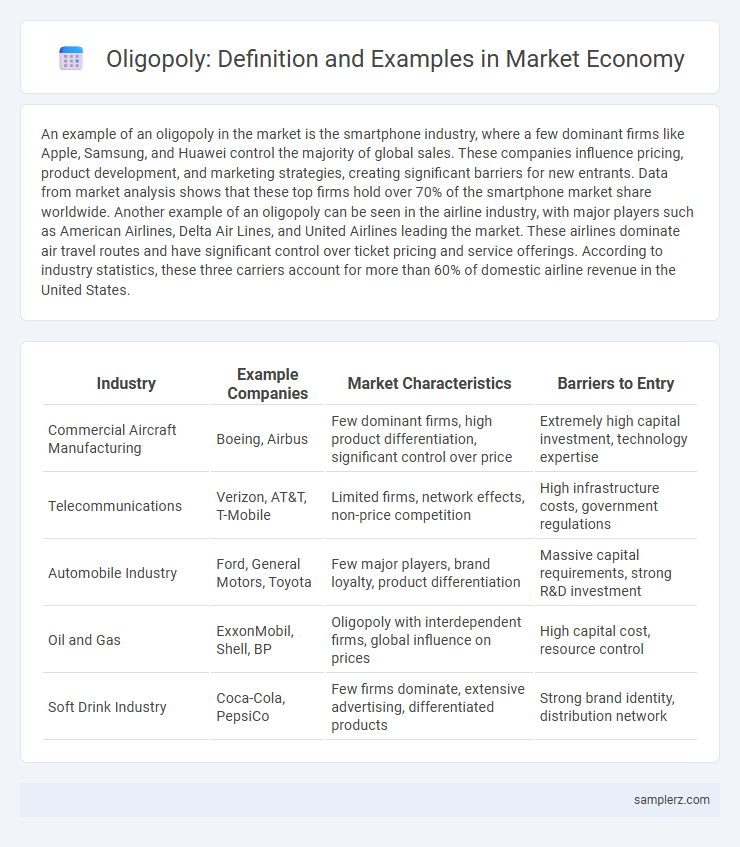An example of an oligopoly in the market is the smartphone industry, where a few dominant firms like Apple, Samsung, and Huawei control the majority of global sales. These companies influence pricing, product development, and marketing strategies, creating significant barriers for new entrants. Data from market analysis shows that these top firms hold over 70% of the smartphone market share worldwide. Another example of an oligopoly can be seen in the airline industry, with major players such as American Airlines, Delta Air Lines, and United Airlines leading the market. These airlines dominate air travel routes and have significant control over ticket pricing and service offerings. According to industry statistics, these three carriers account for more than 60% of domestic airline revenue in the United States.
Table of Comparison
| Industry | Example Companies | Market Characteristics | Barriers to Entry |
|---|---|---|---|
| Commercial Aircraft Manufacturing | Boeing, Airbus | Few dominant firms, high product differentiation, significant control over price | Extremely high capital investment, technology expertise |
| Telecommunications | Verizon, AT&T, T-Mobile | Limited firms, network effects, non-price competition | High infrastructure costs, government regulations |
| Automobile Industry | Ford, General Motors, Toyota | Few major players, brand loyalty, product differentiation | Massive capital requirements, strong R&D investment |
| Oil and Gas | ExxonMobil, Shell, BP | Oligopoly with interdependent firms, global influence on prices | High capital cost, resource control |
| Soft Drink Industry | Coca-Cola, PepsiCo | Few firms dominate, extensive advertising, differentiated products | Strong brand identity, distribution network |
Key Characteristics of Oligopoly Markets
Oligopoly markets are characterized by a small number of dominant firms that hold significant market power, leading to high barriers to entry and limited competition. These firms often engage in strategic decision-making, where the actions of one directly influence the responses of others, resulting in interdependent pricing and output strategies. Product differentiation can vary, but the market typically features either homogeneous or differentiated products, with firms wielding considerable control over prices without facing perfect competition.
Notable Oligopoly Examples in the Tech Industry
The tech industry features notable oligopolies such as Google, Apple, Microsoft, Amazon, and Facebook, which dominate key market segments including search engines, operating systems, cloud computing, e-commerce, and social media platforms. These companies control significant market shares, creating high entry barriers for startups and influencing pricing, innovation, and consumer choices globally. Their interdependent strategies and investments in research and development solidify their positions as leading oligopolistic entities in the technology sector.
Oligopolies in the Global Automobile Sector
The global automobile sector exemplifies an oligopoly with key players such as Toyota, Volkswagen, Ford, General Motors, and Hyundai dominating market share and shaping industry trends. These firms engage in strategic pricing, innovation, and marketing while barriers to entry prevent small competitors from gaining significant foothold. Market concentration in the automotive industry drives competitive dynamics and influences global supply chains, trade policies, and consumer choice.
Major Airline Alliances as Oligopoly Cases
Major airline alliances such as Star Alliance, OneWorld, and SkyTeam represent oligopoly structures in the global aviation market, where a few dominant players control the majority of air traffic and routes. These alliances enable member airlines to coordinate schedules, share codes, and optimize route networks, limiting competition and enhancing market power. The high barriers to entry, including regulatory approvals and extensive capital requirements, reinforce the oligopolistic nature of these alliances in the airline industry.
Telecommunications: Leading Oligopolies Worldwide
The global telecommunications market is dominated by a few leading oligopolies such as AT&T, Verizon, Vodafone, and China Mobile, which control a significant share of the industry's revenue and infrastructure. These companies leverage extensive networks and technological investments to maintain high barriers to entry, limiting competition and enabling price-setting power. The oligopolistic structure in telecommunications drives innovation while often resulting in higher consumer prices and limited service options.
Soft Drink Industry: Coca-Cola and PepsiCo Duopoly
The soft drink industry exemplifies an oligopoly dominated by Coca-Cola and PepsiCo, controlling over 70% of the global carbonated beverage market. These companies leverage extensive distribution networks, aggressive marketing strategies, and brand loyalty to maintain market power and limit competition. Their pricing strategies and product innovation significantly influence industry trends and consumer preferences worldwide.
The Role of OPEC in the Oil Market Oligopoly
OPEC, as a prominent oligopoly, wields significant influence over global oil prices by collectively managing production levels among its member countries. This cartel's coordinated output decisions stabilize supply, reduce market volatility, and impact international energy trade dynamics. The organization's strategic control underscores how oligopolistic behavior shapes resource allocation and economic power within the global oil industry.
Pharmaceutical Giants and Oligopolistic Control
Pharmaceutical giants like Pfizer, Johnson & Johnson, and Novartis dominate the global market through oligopolistic control, influencing drug prices and innovation rates. These firms leverage extensive patents and research capabilities to maintain high market entry barriers, limiting competition from smaller companies. Oligopoly dynamics in this sector result in price rigidity and strategic collaborations, impacting global healthcare accessibility and policy decisions.
Supermarkets and Retail Grocery Oligopolies
Supermarkets and retail grocery industries exemplify oligopolies where a few dominant firms like Walmart, Kroger, and Costco control the majority of market share and influence pricing strategies. These companies leverage economies of scale and extensive supply chain networks to maintain competitive advantages and barrier entries. The concentrated market structure often results in limited competition, impacting consumer choice and pricing dynamics within the grocery sector.
Media and Broadcasting Industry Oligopoly Examples
The media and broadcasting industry exhibits classic oligopoly characteristics with a few dominant firms controlling the majority of market share, such as Comcast, Disney, and Warner Bros. Discovery in the United States. These companies influence pricing, content distribution, and advertising rates, limiting competition and shaping consumer choices. Market concentration metrics, like the Herfindahl-Hirschman Index (HHI), highlight the significant dominance of these entities within the sector.

example of oligopoly in market Infographic
 samplerz.com
samplerz.com